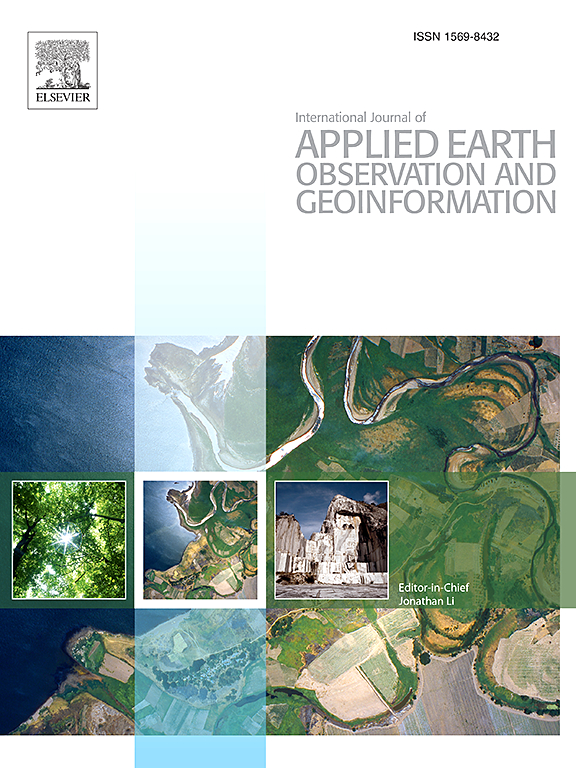A mixed convolution and distance covariance matrix network for fine classification of corn straw cover types with fused hyperspectral and multispectral data
IF 7.6
Q1 REMOTE SENSING
International journal of applied earth observation and geoinformation : ITC journal
Pub Date : 2024-10-17
DOI:10.1016/j.jag.2024.104213
引用次数: 0
Abstract
Effective management of corn straw and stubble is critical in conservation tillage, as it impacts soil health and productivity. However, accurate classification of different types of straw cover has been hindered by their similar spectral and spatial characteristics and the low spatial resolution of hyperspectral satellite imagery. Moreover, traditional convolution neural network (CNN)-based methods, which rely on first-order statistics for feature extraction, often struggle to extract distinguishable features of highly similar objects effectively, thereby reducing classification accuracy. In this study, a second-order statistical-feature extraction algorithm based on CNN that uses fused multispectral and hyperspectral data was tested for its ability to classify types of straw cover. In the first step, coupled non-negative matrix factorization (CNMF) was used to fuse hyperspectral and multispectral images effectively, thereby enhancing the spatial resolution of the hyperspectral data. In this study, we integrated pointwise convolution (PWC), depthwise convolution (DWC), and a distance covariance matrix (DCM) to form a mixed convolution and DCM (MCDCM) network; we used this to extract and integrate deep spectral–spatial features of the hyperspectral images. Our experimental results show that the MCDCM network significantly improved classification accuracy compared to traditional methods, with accuracy rates for the different straw-cover types exceeding 90% and overall accuracy reaching 98.26%. The fused image also exhibited better preservation of feature edges and contours. The accurate identification of corn-straw-cover types achieved with the proposed MCDCM method is a major step in optimizing conservation-farming practices, improving soil fertility and farm productivity, and supporting sustainable ecological development.
利用融合高光谱和多光谱数据对玉米秸秆覆盖类型进行精细分类的混合卷积和距离协方差矩阵网络
玉米秸秆和残茬的有效管理对保护性耕作至关重要,因为它会影响土壤健康和生产力。然而,由于不同类型的秸秆覆盖物具有相似的光谱和空间特征,而且高光谱卫星图像的空间分辨率较低,因此阻碍了对它们的准确分类。此外,基于卷积神经网络(CNN)的传统方法依赖一阶统计进行特征提取,往往难以有效提取高度相似物体的可区分特征,从而降低了分类精度。本研究测试了基于 CNN 的二阶统计特征提取算法使用融合多光谱和高光谱数据对秸秆覆盖类型进行分类的能力。第一步,使用耦合非负矩阵因式分解(CNMF)有效融合高光谱和多光谱图像,从而提高高光谱数据的空间分辨率。在本研究中,我们整合了点卷积(PWC)、深度卷积(DWC)和距离协方差矩阵(DCM),形成了混合卷积和 DCM(MCDCM)网络;我们用它来提取和整合高光谱图像的深度光谱空间特征。实验结果表明,与传统方法相比,MCDCM 网络显著提高了分类准确率,不同秸秆覆盖类型的准确率超过 90%,总体准确率达到 98.26%。融合后的图像还能更好地保留特征边缘和轮廓。利用所提出的 MCDCM 方法实现玉米-秸秆覆盖类型的准确识别,是优化保护性耕作实践、提高土壤肥力和农业生产力、支持可持续生态发展的重要一步。
本文章由计算机程序翻译,如有差异,请以英文原文为准。
求助全文
约1分钟内获得全文
求助全文
来源期刊

International journal of applied earth observation and geoinformation : ITC journal
Global and Planetary Change, Management, Monitoring, Policy and Law, Earth-Surface Processes, Computers in Earth Sciences
CiteScore
12.00
自引率
0.00%
发文量
0
审稿时长
77 days
期刊介绍:
The International Journal of Applied Earth Observation and Geoinformation publishes original papers that utilize earth observation data for natural resource and environmental inventory and management. These data primarily originate from remote sensing platforms, including satellites and aircraft, supplemented by surface and subsurface measurements. Addressing natural resources such as forests, agricultural land, soils, and water, as well as environmental concerns like biodiversity, land degradation, and hazards, the journal explores conceptual and data-driven approaches. It covers geoinformation themes like capturing, databasing, visualization, interpretation, data quality, and spatial uncertainty.
 求助内容:
求助内容: 应助结果提醒方式:
应助结果提醒方式:


